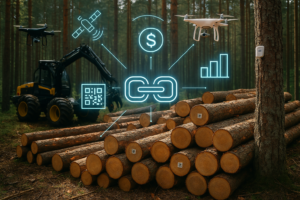Digital shift in the timber sector
According to Prof. Maskeliūnas, today’s timber supply chain operates in fragmented systems – loggers, transport companies, processors, and traders all use separate platforms, making it difficult to verify where wood truly comes from.
“We want to be certain that the wood we use does not originate from a hostile country, that trees are not cut unnecessarily, that environmental damage is properly compensated, and that the logs are processed using clean energy. To guarantee all this, we need a tracking chain that cannot be altered at any stage – and blockchain technology makes that possible,” says the KTU researcher.
In the system developed by KTU scientists, every unit of timber is given a unique identifier, and all related events are recorded on the blockchain. Each step – from issuing a logging permit to transportation and sale – becomes a verifiable entry that cannot be changed or falsified.
“This allows the system to function without a central authority – data is distributed across many participants, and everyone sees the same information,” adds Prof. Maskeliūnas.
The system also uses smart contracts, which automatically check and validate every action. They confirm permit validity before cutting can begin, update transportation details in real time and ensure that no step is executed unless all required conditions are met. “A smart contract is essentially code running on the blockchain that automatically enforces specific rules,” he explains.
Through these mechanisms, no participant in the supply chain can alter information without the agreement of all others.
Sustainability becomes a competitive advantage
The system stands out because it not only tracks timber but also actively manages the trading process. Using smart contracts, buying and selling orders are automatically matched based on price and sustainability criteria. The two-factor algorithm developed by the researchers prioritises responsibly sourced timber rather than selecting only by the lowest price.
“Our model integrates sustainability directly into the trading process – it encourages market participants to act responsibly, because sustainably harvested or processed timber becomes more competitive,” says the professor.
To evaluate system performance, the team carried out simulation experiments. The system achieved up to 550 transactions per second, while participants with higher sustainability scores reached up to 95 per cent successful trades. These results show that the trading algorithm not only records actions – it actively encourages responsible behaviour across the market.
The system also reduces bureaucracy, lowers the risk of human error and helps prevent illegal logging. Each supply-chain event must be confirmed by all relevant parties, while smart-contract algorithms automatically block any action that violates predefined rules – such as cutting without a valid permit or attempting to add a fictitious supplier.
This creates direct financial benefits for responsible businesses. “In a transparent market, sustainability becomes a competitive advantage – such timber gains value, and companies that follow the rules automatically become more reliable partners,” notes Prof. Maskeliūnas.
Looking ahead, the researcher believes that technologies like this could become a foundation of future forestry. The system’s architecture is designed to remain scalable, efficient and secure as more participants join the network.
“Blockchain will transform sustainable forestry – shifting from passive monitoring to active value creation. Such systems will encourage sustainable production and allow every participant in the chain to contribute meaningfully to environmental protection,” he emphasises.
Article Blockchain-enabled smart contracts for secure and transparent timber traceability can be found here.



